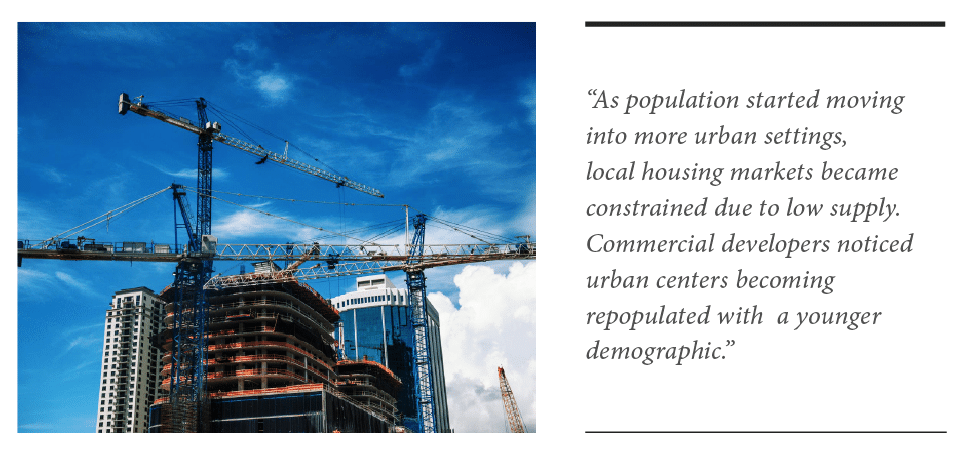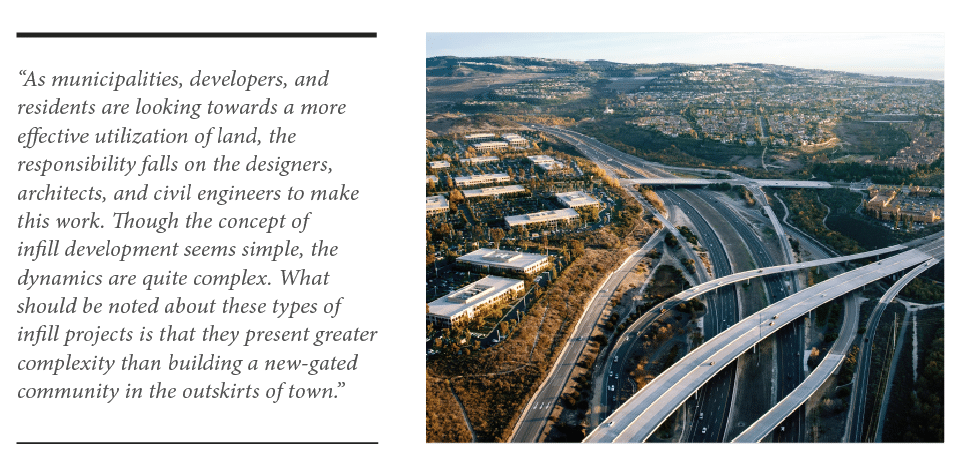By Ali Monshizadeh and Mark Fotohabadi of civil engineering firm MFKessler
The need for development is on the rise. Whether it’s in the form of a need for more housing, more commercial space, or more retail space, there is always a need for more development. The question has always been, “Where is it best to develop?”
A common phenomenon we are witnessing in densely populated settings across America is infill development. From a technical standpoint, the land is continuously being re-utilized to be used more efficiently. As cities and urban areas have morphed from the turn of the century, more eager residents have flocked to urban areas. Urban settings are being re-engineered to become more inviting to residents, especially to younger adults.
At MFKessler, fortunately, we get to witness this sort of infill planning on a daily basis and have been providing engineering consulting services to visionary infill developers since the early 2000s. The most common concept of infill development is converting low-density residential and commercial space to high-density residential and mixed-use spaces. This inherently causes a chain effect. Industrial space is then converted to commercial space, retail space is strategically placed within these new developments, and then industrial space is pushed further outside of the cities. This cyclical nature of real estate development is what helps build sustainable communities for us all to enjoy.
Infill Development is the New Urban Planning
There was a time when planned cities were all the rage among urban developers. The sheer success of places such as Canberra in Australia and Irvine in California fueled the expectations of urban planners who learned from the painful lessons of Brasilia and the Chinese ghost cities of Ordos Kangbashi; however, the collapse of the American real estate economy in 2008 presented a new challenge as these suburbs were becoming less affordable.
In the midst of the American real estate bonanza that started shortly after the year 2000, master-planned residential developments provided homeowners with suburban paradises often located far from commercial centers, and this was not much of a problem back then; household earners did not mind spending hours each month driving back and forth from work, schools, parks, malls, and movie theaters. With this lifestyle, suburban sprawl was not a concern since developers believed that prosperity would continue unabated, thus prompting future zoning and construction of commercial districts, office parks, schools, and infrastructure.
Infill Development Returns to Downtown Areas
Opportunities ripe for infill development were noticed during the exodus from the suburbs to urban centers. As population started moving into more urban settings, local housing markets became constrained due to low supply. Commercial developers noticed urban centers becoming repopulated with a younger demographic.

In some downtown districts, infill development has consisted of luxury condominium towers, some of them with mixed zoning provisions that allow merchants to set up shop on the lower levels. Elsewhere, historic districts near downtown areas have adjusted their zoning so that owners of renovated homes can operate cafés, boutiques and art galleries. In some places, old car dealerships are converted to condominium projects with retail elements fronting major streets. These are examples of infill development initiatives that strike a commercial and residential balance, as they should in urban centers, and planners have preferred this kind of development as opposed to looking for greenfield opportunities that may be more affordable to develop, but that in the end will only contribute to sprawl outwards.
Acceptance of Infill Development
What is interesting about the current wave of infill development is that it is being embraced with enthusiasm in many urban centers. Planning committees are very active fielding objections from neighbors and local business owners. Some municipalities, especially those with historic character, often require developers to maintain that character throughout the transformation. Municipalities offer bonuses for developers who build affordable housing into their projects. Most municipalities require a public use element within the new development. Residents often become welcoming of such developments. There is always the inconvenience of construction, but neighborhoods are revitalized, property values rise, and local businesses prosper.
Positive reactions to infill development may be a bit more difficult to elicit in housing markets such as California, and this is despite the desperate need for housing solutions in the Golden State. The problem in California is that a 2017 study published by Berkeley University suggests that the need for 1.9 million housing units could be solved by infill development; however, the carbon footprint of such a massive construction project becomes a concern in a state where greenhouse gas emissions are subject to considerable restrictions. Still, when considering the carbon footprint of sprawl coupled with the increased driving that suburban and exurban neighborhoods would create, infill development is becoming more welcomed by communities in California.

The Dynamics of Infill Development
As municipalities, developers, and residents are looking towards a more effective utilization of land, the responsibility falls on the designers, architects, and civil engineers to make this work. Though the concept of infill development seems simple, the dynamics are quite complex. What should be noted about these types of infill projects is that they present greater complexity than building a new-gated community in the outskirts of town. Municipal planning for such changes requires years of planning and studies. These projects are being developed in the midst of code amendments and new zoning schemes. Studies on architecture, zoning, infrastructure, and environmental elements take years and require great expertise.
It pays to have the right team on your side in the development of infill projects. It takes more than a vision to ensure that infill projects succeed. Deciphering development codes, presenting an architecture that works with the environment, while ensuring there is sufficient infrastructure to support the project, all while reducing environmental impacts of the project, are key aspects a great design team evaluates. Where land prices are astronomical, every square foot of property counts. The complexity of design in metropolitan settings brings the need for experts who have dealt with such municipalities.
Civil engineers like MFKessler are tasked with fitting these new developments within the confines of previously developed land and to the complex municipal standards that govern such developments. Concepts such as mapping and boundary issues, traffic elements, and infrastructure to serve these new developments are complex.
Over the years, our firm has helped many developers design and build these developments into cities across California and Nevada and we have assisted them in navigating the maze of overseeing agencies. Whether carving out a hillside to allow for a multi-story apartment complex, converting an abandoned car dealership center to a vibrant mid-density neighborhood, replacing a concrete box parking structure in downtown Los Angeles with a sleek multi-component mixed-use high-rise, converting an asphalt parking lot in San Diego to a mid-rise residential development, or replacing single-family homes with luxurious low-rise condominiums in Santa Monica and Newport Beach; we see a promising future for infill development projects in the urban planning landscape.





